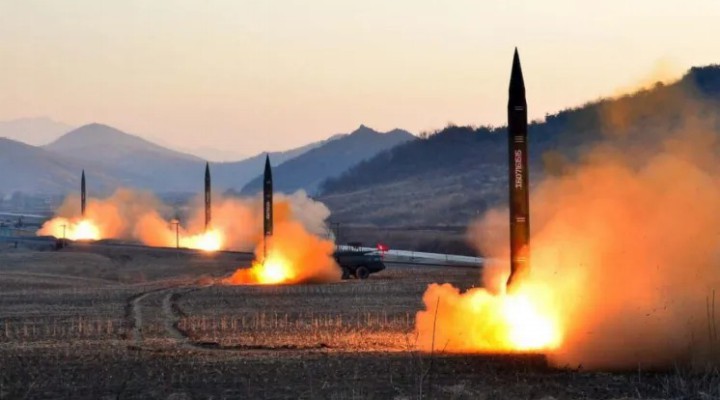Checkmate

The Iranian defeat of the US-Israeli missile defense architecture has global security consequences.
The world’s attention has, rightfully so, been focused on the fallout from Iran’s retaliatory strike against Israel on April 13-14, 2024. Iran’s purpose in launching the attack was to establish a deterrence posture designed to put Israel and the United States on notice that any attack against Iran, whether on Iranian soil or on the territory of other nations, would trigger a retaliation which would inflict more damage on the attacker than the attacker could hope to inflict on Iran. To achieve this result, Iran had to prove itself capable of overcoming the ballistic missile defense systems of both Israel and the United States which were deployed in and around Israel at the time of the attack. This Iran was able to accomplish, with at least nine missiles striking two Israeli air bases that fell under the protective umbrella of the Israeli-US missile defense shield.
The Iranian deterrence posture has implications that reach far beyond the environs of Israel or the Middle East. By defeating the US-Israeli missile defense shield, Iran exposed the notion of US missile defense supremacy that serves as the heart of US force protection models used when projecting military power on a global scale. The US defensive posture vis-à-vis Russia, China, and North Korea hinges on assumptions made regarding the efficacy of US ballistic missile defense capabilities. By successfully attacking Israeli air bases which had the benefit of the full range of US anti-ballistic missile technology, Iran exposed the vulnerability of the US missile defense shield to modern missile technologies involving maneuverable warheads, decoys, and hypersonic speed. US bases in Europe, the Pacific and the Middle East once thought to be well-protected, have suddenly been revealed to be vulnerable to hostile attack. So, too, are US Navy ships operating at sea.
Israel’s ballistic missile defenses were given a supercharged boost by the deployment of an advanced AN/TPY-2 X band radar on Israeli soil. The radar, operated by the US Army’s 13th Missile Defense Battery, is located on Har Qeren, a height which rises out of the Negev Desert near the city of Be’er Sheva. The AN/TPY-2 is a missile defense radar that can detect, track and discriminate ballistic missiles, discriminating between threats and non-threats (i.e., incoming missiles and space debris).
The AN/TPY-2 operates in two different modes. The first, known as the “forward-based mode,” detects and tracks ballistic missiles as they are launched. The second—“terminal mode”—is used to guide interceptors toward a descending missile. The AN/TPY-2 is optimized to work with the Terminal High Altitude Area Defense (THAAD) ballistic missile defense system by guiding the THAAD missile to its target.
The US had deployed at least one, and possibly two, THAAD missile batteries to Israel at the time of the Iranian missile attack. In addition to assisting the THAAD missiles in shooting down incoming threats, the AN/TPY-2 radar data was integrated with Israeli radar data and other technical intelligence collected by the Ballistic Missile Defense Organization’s (BMDO) network of early warning satellites deployed for the sole purpose of monitoring and reporting Iranian ballistic missile launches. This integrated early warning/surveillance/tracking system was tied into a multi-layered missile defense architecture which included the US THAAD and Israeli Arrow 2, Arrow 3, advanced Patriot, and David’s Sling anti-ballistic missile interceptor systems.
Adding to the capability and lethality of the US-Israeli ballistic missile defense architecture was the presence of at least two US Navy ballistic missile defense (BMD) system-capable Aegis-class destroyers equipped with the SPY-1 S band radar and SM-3/SM-6 interceptor missiles. The Navy BMD-capable ships are configured to tie into the ground-based AN/TPY-2 X band radar as well as the broader BMD system through the Command and Control, Battle management, and Communications (C2BMC) system. The combination of ground-based radars and interceptors with the US Navy BMD system provides US military commanders with theater-wide protection from hostile ballistic missile threats. This integrated system is designed to detect, acquire, and track incoming threats and, using complex computer-drive algorithms, discriminate targets and destroy them using hit-to-kill kinetic warheads (i.e., a “bullet hitting a bullet”).
On April 13-14, 2023, this system failed. In short, the combination of US and Israeli anti-ballistic missile defense capabilities deployed in and around the Negev desert made the Israeli air bases located there the most protected locations in the world from threats posed by ballistic missiles.
And yet Iran successfully struck both locations with multiple missiles.
The global strategic implications of this stunning Iranian accomplishment are game-changing—the US has long struggled conceptually with the notion of what is referred to as “A2/AD” (anti-access/area denial) threats posed by hostile ballistic missiles. However, the US had sought to mitigate against this AA/A2 threat by overlaying theater ballistic missile defense architecture like that that had been employed in Israel. The failure of the combined US-Israeli defense systems in the face of a concerted Iranian missile attack exposed the short-comings of the US ballistic missile defense capabilities world-wide.
In short, this means that the US and NATO forces in Europe are vulnerable to attack from advanced Russian missile technologies which match or exceed those used by Iran to attack Israel. It also means that China would most likely be able to strike and sink US navy ships in the Pacific Ocean in the event of a conflict over Taiwan. And that North Korea could do the same to US ships and forces ashore in the vicinity of Japan and South Korea.
Until which time the US can develop, produce and deploy missile defense systems capable of defeating the new missile technology being deployed by nations like Iran, Russia, China, and North Korea, US military power projection capabilities are in a state of checkmate by America’s potential adversaries.
 TheAltWorld
TheAltWorld 
0 thoughts on “Checkmate”